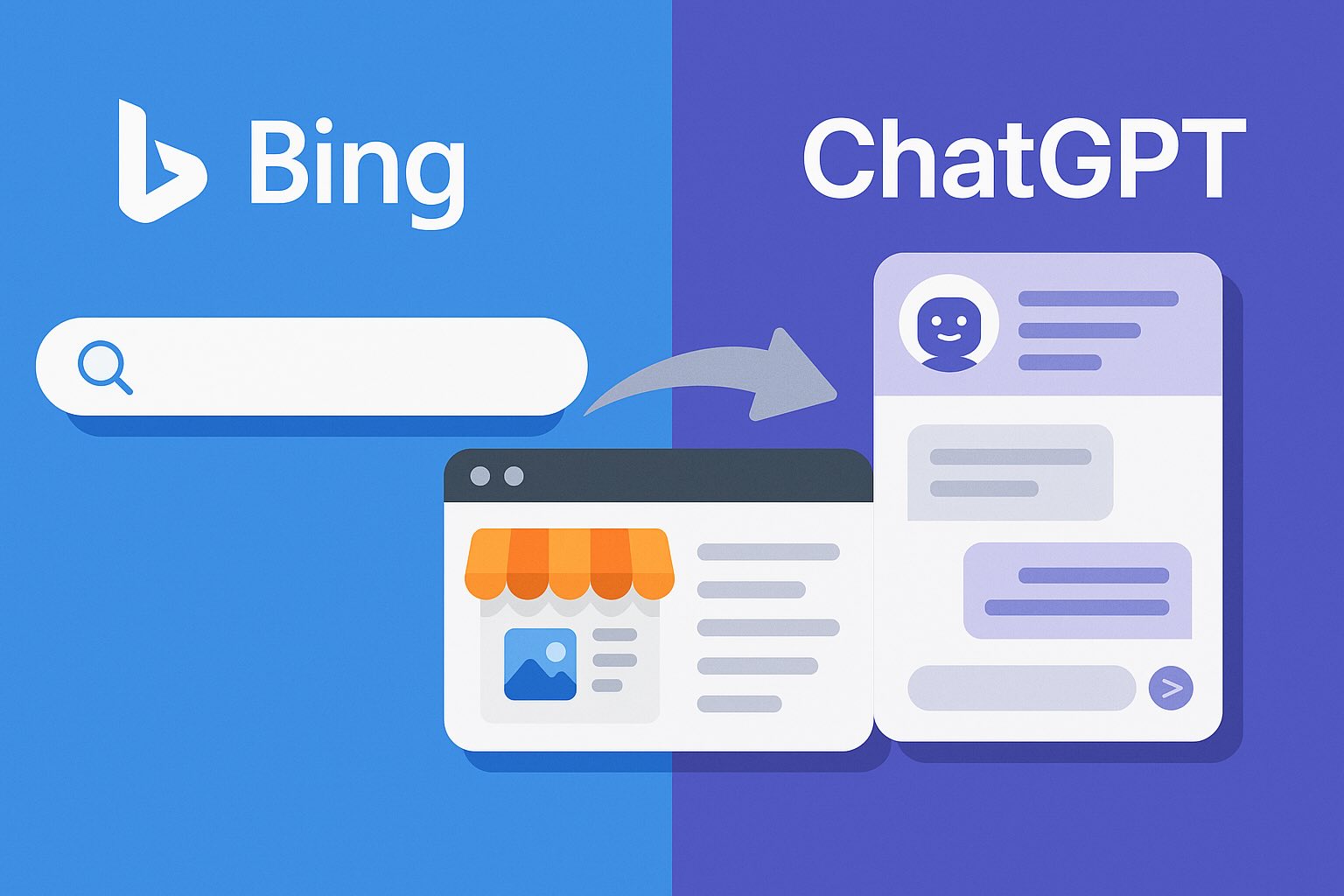You might not use Bing. But ChatGPT’s browsing tool does. So does Microsoft Copilot, Windows Search, and a growing number of AI tools built on Microsoft’s stack.
If Bing can’t see your site, tools that rely on it won’t either.
That’s a problem. Because those tools are quickly becoming the way people search, compare, and buy.
Let’s look at why Bing SEO matters in 2025 and what you can do about it.
Why Bing Isn’t Just “That Other Search Engine” Anymore
Microsoft’s partnership with OpenAI is deep. If Bing indexes your site, you’ve got a real chance of being referenced, summarised or quoted across platforms like ChatGPT, Copilot and LinkedIn.
If Bing can find you, ChatGPT and Copilot might mention you. If it can’t, you’re not in the conversation.
Want to see how ChatGPT and Google compare? This post breaks it down.
- ChatGPT’s Browse with Bing feature
- Microsoft Copilot in Office, Edge, and Windows
- LinkedIn’s built-in search enhancements
- Enterprise AI tools powered by Bing’s API
Bing’s Algorithm Is Simpler and Easier to Optimise For
Unlike Google, which demands backlinks, EEAT, and constant firefighting, Bing rewards structure and clarity.
- Exact-match and partial-match domains
- Strong meta titles and descriptions
- Fast loading websites
- Keyword-targeted content
- Well-structured content with H2s and schema
- Less obsession with backlinks (but they do help)
That’s a win for smaller sites and lean SEO teams. You don’t need a 200-page content plan or a fancy PR team to rank on Bing.
And based on our campaigns, Bing traffic tends to convert better too. On average, clients see around 50% higher conversion rates than on Google Ads.
Content That Gets Picked Up by Bing and AI Tools
Structured Listicles
These work especially well for small product brands and local service providers. Think:
- Best e-bikes for commuters
- Top kitchen styles for small homes
- 5 natural ways to reduce anxiety
Listicles are easy to crawl, easy to summarise, and loved by both Bing and ChatGPT. Use clear H2s, bullets and schema like Article, FAQPage or HowTo. Here’s a guide on how to structure blog posts for SEO.
Review and Comparison Pages
If you’re selling anything from supplements to smart devices, you need comparison content. For example:
- Magnesium vs Ashwagandha for stress
- Which folding e-bike is best for small homes?
- Osteopath or chiropractor — which one should you see?
This content feeds into both product search and generative answers. Use Product and Review schema, and add genuine customer feedback where possible.
Ecommerce SEO That Feeds into Bing and ChatGPT
If you run a Shopify or WooCommerce store, here’s where things get interesting. There’s a native integration that lets ChatGPT users browse Shopify products directly.
Optimise Product Pages
Use structured data like:
- Product
- Offer
- Review
- ImageObject
Keep titles and descriptions clear. Add real reviews and strong visuals. You’re not just trying to rank — you’re helping AI understand your products.
Submit to Microsoft Merchant Center
Get listed in:
- Bing Shopping
- Copilot-integrated Windows search
- Chat-based product lookups
Local Businesses: Bing Still Has Reach
Bing Places for Business
Bing Places is free and especially useful for service-based professionals like:
- Therapists and nutritionists
- Cleaners and property managers
- Mobile hairdressers or personal trainers
Local FAQs Work Brilliantly
Try answering questions like:
- How much does CBT cost in Tunbridge Wells?
- Is homeopathy safe during pregnancy?
- What should I look for in an e-bike for hills?
Use Bing Webmaster Tools to Stay on Track
You can:
- Submit your sitemap
- Track crawl and index status
- See which keywords Bing ranks you for
- Monitor backlinks
- Strengthen your brand and entity relationships
For more on technical SEO, check out The Three Kings of SEO.
Final Thoughts
Bing SEO is no longer optional. It’s a shortcut into the world of AI-powered visibility. Tools like ChatGPT and Copilot use Bing data to feed results.
If you ignore Bing, you’re shutting the door on an emerging wave of discovery.
Want your site to show up in Google, Bing, and the AI layer on top? Book your free SEO audit here.
Bing SEO and AI Visibility: Frequently Asked Questions
Why should I care about Bing if most of my traffic comes from Google?
Bing powers ChatGPT, Microsoft Copilot, Windows Search, and more. Getting indexed by Bing helps you appear inside AI tools that your audience may already be using — even if they never visit Bing.com.
How much traffic does Bing actually get?
Globally, Bing holds about 3 to 9 percent of desktop traffic, depending on the region. But it also powers discovery through tools like ChatGPT and LinkedIn. That makes it an indirect traffic source that still matters.
What are the benefits of using Bing for SEO?
Bing rewards proper structure, clear meta data, and schema markup. It’s also less focused on backlinks than Google. That makes it easier for small businesses to compete and gain visibility faster.
Will Bing help my products appear in ChatGPT?
Yes. ChatGPT’s browsing tool pulls data from Bing. If your products are well structured, listed in Bing Shopping, and hosted on platforms like Shopify, there’s a higher chance they’ll surface in AI-generated responses.


